
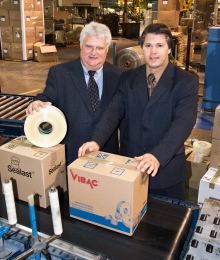
Photo by Sandra Strangemore
Sticking it out in challenging economic times is nothing new to folks at Vibac Canada Inc., one of Canada’s leading manufacturers of pressure-sensitive adhesive tapes based in Montreal.
The key is to use any lulls in production wisely as an opportunity to make sure you have the right production equipment in place to handle new business when the good times return, according to Rino Petrella, executive vice-president of Vibac Canada, part of the Italian-headquartered, globally-operating Vibac Group of companies specializing in production of polypropylene films for the packaging and labeling industries, as well as a wide variety of polypropylene, synthetic and natural-rubber adhesive tapes used in industrial and consumer applications.
Founded in the early 1970s, the Vibac Group employs well over 1,000 people at tape and film production facilities around the world—including plants in Montreal and Lanoraie, Que.; three plants in Italy; and an expansive production site in Morristown, Tenn.
Started up in 1976, the company’s Montreal operation, also serving as its Canadian headquarters, employs 100 people at a 175,000-square-foot building to produce a diverse offering of pressure-sensitive carton-sealing tapes, while the company’s other Canadian-based factory in Lanoraie employs 105 people to manufacture specialty films for labeling and flexible packaging applications.
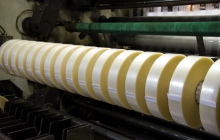
Photo by Sandra Strangemore
“Our Montreal plant has the capacity to produce 450 million square meters of BOPP (biaxially-oriented polypropylene) films annually,” says Petrella, who has been with the company since 1981—long enough to see a night-and-day transformation of the company from a modest-sized
distribution outlet for Vibac products into what is today a highly-efficient, highly-automated, vertically-integrated tape manufacturer employing a dazzling range of cutting-edge robotic technologies to optimize its production flexibility and efficiencies.
Producing its own synthetic and natural tapes on-site, the Montreal plant is also a major client for the company’s recently-upgraded sister facility in Morristown, Petrella explains.
“We get all of our film needs looked after by the Morristown facility we built in 1998, as well as by the Lanorie plant,” Petrella told Canadian Packaging, revealing that an estimated US$80-million upgrade of the Morristown plant last year—expanding its production space to 320,000-square-feet and adding 35,0000 tons of film to its annual production capacity—made the Morristown plant “one of the largest film manufacturing facilities in the world … and we are one of its biggest customers.”

Photo by Sandra Strangemore
While competition in the tape manufacturing business is fairly fierce, Petrella acknowledges, Vibac Canada has been able to grow over the years by consistently producing high-quality products at reasonable prices, along with a good knack for product innovation driven by the parent company’s proactive emphasis on intensive R&D (research-and-development) activities.
“Our know-how is based on the identification and selection of high-quality polymers and additives.
“Vibac Canada, and Vibac as a whole, has never tried to be a ‘jack-of-all-trades, master-of-none’ type of enterprise,” Petrella confides, “but rather to be a company that will offer new products only after we can assure ourselves, and our customers, that we have mastered the art of manufacturing it.
“Why offer products just to cover the full spectrum of the market if you can’t ensure that you are providing the market with the very best a that a product can be?”, Petrella asserts. “That’s why Vibac concentrates on being the best at certain products—so that when someone purchases them, they can be sure that they’re going to get high-quality products.”
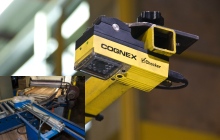
Photo by Sandra Strangemore
According to Petrella, Vibac was the first company in the world to develop and patent a BOPP surface-printable tape that uses synthetic rubber for a bonding adhesive—commonly used today as printable security tapes that can display custom-made logos and graphics—while more recently, Vibac introduced a new range of environmentally-friendly, biodegradable tapes utilizing natural rubbers as the boding agent.
“We make sure that our laboratories are equipped with the most high-performing testing and instrumentation systems available,” Petrella asserts.
This emphasis on product innovation naturally extends to the way Vibac Canada goes about its production process, adds Petrella, citing a 2005 installation of nine high-performance industrial robots supplied by a leading robotics manufacturer FANUC Robotics America Inc.
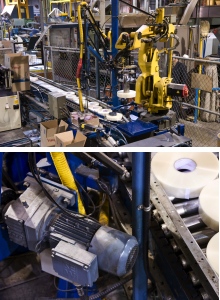
Photo by Sandra Strangemore
“Putting in nine robots was definitely a large undertaking for us,” Petrella recalls, “but if you’re going to upgrade your production in a meaningful way, you might as well do it right the first time.
“Because Vibac also places a high emphasis on finding ways to make our production departments work more efficiently,” he expands, “we decided a few years ago to get away from the more traditional types of packaging equipment we were using at the time, and took a good look at robotics as a long-term solution for our production needs, specifically for the packaging and palletizing of our products.”
Despite the substantial financial commitment up front, Petrella says
the high initial capital expenditures are well-justified in the context of a speedy anticipated ROI (return-on-investment) that the Fanuc robotics will provide compared to the previously-employed, standard cartoning equipment.
“Utilizing these robots has dramatically reduced set-up times for us,” Petrella states. “Whereas before it may have taken us 20 or 30 minutes to set up a run, today it just takes seconds.
“Moreover, because the Fanuc robots require very little maintenance—perhaps an oil change every six months and maybe the replacement of a faulty suction cup—it means far less production downtime,” he stresses, “and a greatly reduced parts inventory in our shop.
“Another factor that influenced us to purchase from Fanuc is their proximity to us,” Petrella adds. “The last thing we wanted or needed was to have our production lines go down because we are waiting for parts or servicing.
“Having Fanuc in close proximity means that if we would ever require their help, we would be able to get a rapid response and have the problem serviced immediately.”
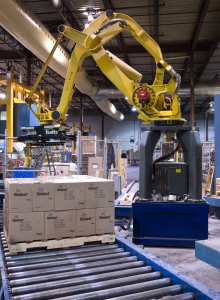
Photo by Sandra Strangemore
While some manufacturers may still think of robotics as a luxury reserved exclusively for the production of high-ticket durable consumer goods, Vibac already had good appreciation of what robotics technology could do for the plant even before the multiple-unit Fanuc installation, having already had installed a robotics-based system called “the giraffe,” which has since been reconfigured to work with the Fanuc packing robots.
“The giraffe picks up a piece of silicone or wax paper—used to add a layer of separation between the levels of tape to prevent them from sticking to each other—with its suction cups, and automatically places it on top a row of packaged tapes, which makes the removal of the product easier for the customer,” notes Petrella.
“By repeatedly executing this simple lateral movement in such a fast manner,” he points out, “the giraffe helps us save on the labor that we can better utilize elsewhere in the plant.”
This familiarity with robotics technology enabled Vibac to offer valuable input right at the commissioning stages of the Fanuc installation project, according to Petrella.
“Even though Fanuc has over 200 robot variations,” he notes, “we still had them tweak the programming on the robots to do exactly what we needed them to do, and they were very forthcoming in working with us and meeting our demands.”
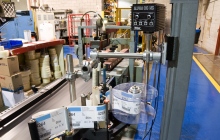
Photo by Sandra Strangemore
For example, the heavy-duty Fanuc palletizing robot utilized in the plant’s end-of-line packaging area was
simplified by adding several dedicated pneumatic and electrical connections, specifically suction cups, onto the robot’s end-of-arm tooling to optimize palletizing operations, Petrella point out, while complimenting the Fanuc packing robots’ modular construction design, six axes of movement, consistent performance, and reduced cycle times ensured by the high-precision motion control capabilities delivered by electric servo-drives.
In addition to the Fanuc robots, the Vibac plant also employs a broad range of other types of advanced packaging and quality assurance technologies, including:
• A Checker machine-vision system manufactured by Cognex—a compact, built-in optical device capable of detecting product defects in high-speed product inspection at rates of up to 6,000 ppm (parts per minute);
• A pneumatic ejection system from Festo for instantaneous spotting of badly packaged tape configurations and their removal off the line;
• A case-coding system from Videojet Technologies for reliable, high-speed application of all the pertinent product lot and code information onto the shipping cases.
• A model Alpha 86 HS labeler, manufactured by Weber Marking Systems, for high-speed application of labels to the cartons utilizing the wipe-on method, whereby the label is automatically peeled from its liner and secured to the carton.
All in all, Petrella says he is confident that the Vibac Canada plant—certified to the internationally-recognized ISO 9001 registration for quality management assurance, as well as the ISO 14001 registration for sustainable manufacturing practices—has all the elements in place to continue manufacturing high-quality, cost-competitive tape products well into the future.
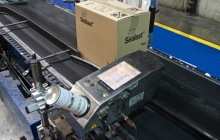
Photo by Sandra Strangemore
“While it’s true that Vibac Canada may not offer the comparatively broad range of products that some of our competitors offer,” he allows, “our competitive strength lies in being able to offer the best products on the market with what we do produce.
“We also take the time and effort to work with our customers to ensure that the product they request is indeed the best product for their particular needs,” he adds. “It may seem obvious, but it is highly important for a tape to close a carton and to keep it closed until someone actually wants to open it.
“It’s like our production line,” Petrella sums up. “To keep the customers happy and satisfied, we need to ensure we have the right equipment to do the best job possible.
Advertisement

